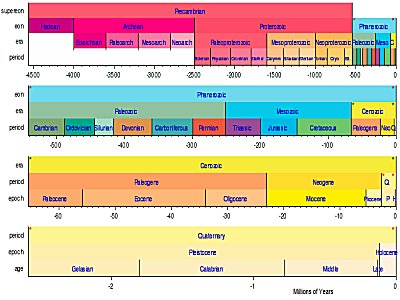Periodization

When dealing with time scales longer than those usually measured by calendars and clocks, the longer-term past can be divided up into convenient periods or blocks of time in a process known as periodization. Although records exist for most of human history, for longer time scales we must rely on geological and paleontological dating techniques.
To some extent, the start and end of identified periods is necessarily somewhat arbitrary (or at least imprecise), and periods may even overlap. But grouping together periods of time with relatively stable characteristics does provide at least some sort of framework to help us understand what would otherwise be a continuous stream of scattered and apparently random events.
Human Time Scale
The labels used for periodization of the more recent past may utilize many different references, including:
- calendar dates (e.g. the 1960s, the 17th Century, etc);
- prominent individuals (e.g. the Victorian Age, the Napoleonic Era, etc);
- historical or political events (e.g. the post-War years, the pre-Columbian Era, etc),
- cultural movements (e.g. the Renaissance, the Romantic Period, etc).
Some usages are necessarily geographically specific (e.g. the Meiji Era of Japan, the Merovingian Period of France, etc), and cultural references in one part of the world may be at odds with those in other parts (e.g. the Italian Renaissance of the 14th to 16th Century, the English Renaissance of the 16th and 17th Century, the Harlem Renaissance of the 1920s, etc). Some periods may even be entirely illusory or mythological in nature (e.g. the Golden Age, the Age of Aquarius).
The periodization of human prehistory typically relies on changes in material culture and technology (e.g. the Stone Age, the Bronze Age, the Iron Age, etc). Within these broad general periods, sub-periods can be identified (e.g. the Stone Age can be divided up into the Paleolithic, Mesolithic and Neolithic Periods; the Bronze Age is sometimes split into the Copper and the Bronze Age; etc). It relies to a large extent on dating techniques such as radiocarbon dating (which is quite accurate within a range of 500 to 50,000 years), and other even longer-scale radiometric dating techniques.
Geological Time Scale

Further back into pre-human history, in what is sometimes referred to as “deep time”, there are no human or archaeological markers to use, and geologists, paleontologists and earth scientists use the geological time scale (or geologic time scale). This time scale splits up periods of the magnitude of many millions of years, utilizing geological and paleontological techniques like stratigraphy (the study of rock layers) and the fossil record of major events like mass species extinctions.
The concept of geological time had its beginnings with the ground-breaking work of the early geologist James Hutton in the 18th Century, who was the first to realize that the Earth must be many millions of years old, not just the few thousands of years maintained by theologians. Hutton’s early work was supported in the 19th Century by fellow Scot Charles Lyell, and later still by Charles Darwin.
The geologic time scale is usually divided up as follows:
- eons and supereons – broad timespans (rarely used) covering half a billion years or more, e.g. Hadean Eon, Achaean Eon, Proterozoic Eon, Phanerozoic Eon.
- eras – intermediate timespans of several hundred million years, e.g. the Phanerozoic Eon is split into the Paleozoic, Mesozoic and Cenozoic Eras.
- periods – intermediate timespans of tens or hundreds of millions of years, e.g. the Mesozoic Era is split into the Triassic, Jurassic and Cretaceous Periods.
- epochs – shorter timespans of tens of millions of years, e.g. the Early, Middle and Late Jurassic Epochs.
- ages – even shorter timespans (also rarely used, apart from in highly technical circumstances) typically covering a few million years each, e.g. Hettangian, Sinemurian, Pliensbachian, etc.
Cosmological Time Scale
Outside of these time scales, and beyond even the age of the Earth, the cosmological time scale applies, using the Big Bang (the creation of the universe itself) as a reference point. Physicists have been able to model the time after the Big Bang with remarkable accuracy (see the section on Time and the Big Bang), and have identified various “epochs” depending on the ambient temperature of the universe and the physical phenomena that arose:
- Planck Epoch – the first 10-43 seconds after the Big Bang, theoretically the smallest time period it would ever be possible to measure, and about which we absolutely nothing.
- Grand Unification Epoch – 10-43 to 10-36 seconds after the Big Bang.
- Inflationary Epoch – 10-36 to 10-32 seconds.
- Electroweak Epoch – 10-36 to 10-12 seconds.
- Quark Epoch – 10-12 to 10-6 seconds.
- Hadron Epoch – 10-6 seconds to 1 second.
- Lepton Epoch – 1 to 10 seconds.
- Photon Epoch – 10 seconds to about 380,000 years.
- Reionization Epoch – about 150 million to about 1 billion years after the Big Bang.
In The Five Ages of the Universe, a popular science book by Fred Adams and Gregory Laughlin, the evolution of the universe, from the deep past to the deep future future, is split into five ages or eras (also see the section on Time and the Big Bang):
- Primordial Era – from the Big Bang to about 350,000 years, or, in terms of orders of magnitude, up to about 105 years.
- Stelliferous Era – stars and galaxies are formed, from 106 to 1014 years.
- Degenerate Era – stars gradually burn out and die, from 1015 to 1039 years.
- Black Hole Era – black holes dominate, but gradually start to break down and evaporate, from 1040 to 10100 years.
- Dark Era – only random, isolated, low-energy particles remain, after 10100 years.